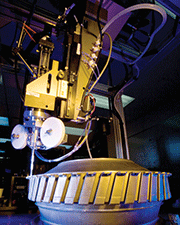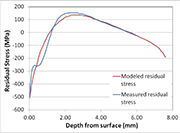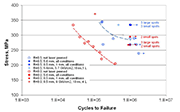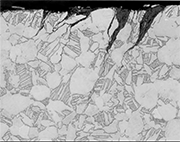E-Archive
Cover Page
in Vol. 15 - March Issue - Year 2014
Laser Peening

Laser peening introduces deep compressive residual stresses into critical fatigue regions of a component

Figure 1: The laser cantilever beam fatigue specimen illustrating the laser-peened area and the modeled residual stress distribution

Figure 2: Comparison of the measured and modeled residual stress profiles through the base of the fillet

Figure 3: The tensile fatigue fretting fatigue life of as-received and laser- peened Ti-6Al-4V at two R levels

Figure 4: Surface shear cracks generated in the surface of a laser-peened tensile fatigue specimen
Introduction
LSP Technologies specializes in the application of high power lasers to improve the endurance, performance, and safety of manufactured components. The company provides laser peening services and laser peening equipment to manufacturers from around the world. LSP Technologies has laser-peened tens-of-thousands of components for OEMs in the aerospace and power generation industries at its location in Dublin, Ohio and in 2014 the company is installing the highest power laser peening equipment in the world into its facility. LSP Technologies also offers a product line of high power, high-pulse-rate laser peening systems for sale, ranging from 20 watts to more than 200 watts.
In addition to laser peening, LSP Technologies� services include a line of Laser Bond Inspection systems, material characterization, fatigue testing, failure and fracture analysis, stress analysis, scanning electron microscope (SEM) imaging, metallography, finite element analysis (FEA), strain gauging, tooling design, residual stress measurements, and prototype and design development.
Laser peening (LP) imparts deep compressive stress into metallic components to inhibit or prevent failure from fatigue, high cycle fatigue, foreign object damage, fretting fatigue, and stress corrosion cracking. Its first industrial application was in 1997 on gas turbine engine blades, and since then the application of laser peening has steadily grown. Many industries have adopted laser peening as a production process to increase the damage tolerance, fatigue life, and strength of critical components. Laser peening in the turbine engine industry, both aerospace and power generation, has grown to include integrally bladed rotors (or blisks), fan blades, compressor airfoils, blade dovetail slots, steam turbine blades, and nuclear reactor vessels. Other applications using the significant fatigue improvements produced by laser peening include biomedical implants, aircraft structural components, and tooling dies. Newer industries and applications incorporating the process include aerospace and large engine crank shafts and other engine components, gears, and wheels. Each of these applications has benefited from the deep compressive stresses imparted by laser peening and its ability to resolve a significant failure problem related to the component (design or material, manufacturing or operation), or to enable the component to be used in a more demanding environment without a redesign.
Laser peening is particularly effective in mitigating the effects of foreign object damage (FOD) on the surface of a part. If the surface of the part is somehow damaged through handling or FOD during operation or service, the remaining life or fatigue strength is significantly reduced as a result of the damage. In many cases, the laser-peened component that experiences such damage retains much of its original fatigue strength as compared to a possible loss of 30 to 75 percent of its fatigue strength and greatly reduced life if not laser-peened. As a result, laser peening can save a company or its customers millions of dollars by increasing part reliability and reducing the number of inspections, downtime, and replacement parts.
In this article, a few aspects of laser peening will be briefly discussed. Laser peening offers options for preventing or inhibiting fatigue failure, stress corrosion cracking, and fretting fatigue of machine and structural components that often afford a solution to a problem that other surface treatments do not. It also can often be used in conjunction with other surface treatments to take advantage of the benefits of each and enhance the resulting property improvements. For example, laser peening would provide deep compressive stresses in the fatigue critical features, such as fillets and holes, while shot peening would provide large area coverage of a shallow surface compressive stress. This approach is being used for turbine blades and other applications.
Modeling Residual Stress for Applications Development
One of the useful characteristics of laser peening is that it can be easily applied to a part exactly where it is needed on areas as small as 1 mm2 or as large as necessary. The usual areas are in the range of about 1 to 100 cm2 in size. The size and shape of the laser-peened area is dictated only by what is required to maximize fatigue life. This gives the design engineer great flexibility to develop the best approach to applying laser peening to a new or existing component. When designing a new component, laser peening expands the design options, enabling more efficient and effective component designs that would not be possible without using laser peening to neutralize more desirable, but normally fatigue-limited features. In addition to flexibility in the location, size and shape of the laser peened areas, the depth of the compressive stresses can be varied over a wide range, from a fraction of a millimeter deep to 5 mm or more by varying the processing conditions.
When introducing deep compressive residual stresses into the fatigue critical regions of a component, the locations and magnitudes of the balancing tensile residual stresses must also be considered. If this is not done, the fatigue failure may just move from the initial location to a nearby location having the highest tensile residual stress. An effective means to defining the processing options to best accomplish this is to use an eigen-strain-based finite element analysis approach. In this approach a finite element model is constructed of the candidate part or component being investigated for laser peening. This model serves as the vehicle for observing the distribution of residual stress within the part for different ways of applying of the laser peening process. With the model in hand, various residual stress patterns can be inserted into the model and the redistribution of the stresses as influenced by the geometry of the part can be observed.
The residual stress profiles inserted into the model represent profiles for different laser peening conditions. In this way the stress profiles that produce an acceptable residual stress distribution within the model represent specific laser peening conditions that can be used to process the part. The residual stress profiles are determined by processing sample blocks of the component alloy at several different laser peening conditions appropriate for the intended application or by referring to a library of these profiles. The residual stress profiles can be obtained by any accepted method, but the slitting method is a relatively inexpensive, readily accessible and reasonably accurate technique to measure the deep compressive stress profiles associated with laser peening. After the residual stress profiles are determined, they are transformed into eigenstrain profiles that can be inserted into the finite element model to generate residual stresses within the model.
The eigenstrain profiles are inserted into the model at the geometric features causing premature fatigue failures or at areas exposed to surface damage leading to fatigue failures. This approach provides great flexibility by applying the residual stresses of different depths over the critical areas, varying the size and shape of the laser-peened area at each location requiring treatment. For each combination of size, shape and laser peening condition applied to the model, the residual stresses formed by the eigenstrains inserted into the model relax to adapt to the model geometry in a way similar to what would be observed by laser-peening the component. Hence, many possible laser peening approaches can be tested in the model to determine the one or two processing conditions which provide the most promising residual stress distributions, before actually processing the part. This significantly reduces the time and cost to develop an optimum laser peening process for a specific part and geometry, saving the customer significant cost and rapidly getting the product into production. In addition, the process cost/time and property benefit tradeoffs can be examined.
An example of the efficacy of this approach is illustrated here using a steel fatigue specimen in the form of a cantilever beam having a fillet as the fatigue stress riser. The residual stress profile in this demonstration was measured in the cantilever beam itself. The beam was laser-peened in the fillet area and the surface stress measured by x-ray diffraction and the depth profile by slitting at the base of the fillet. The measured residual stresses were then converted to eigenstrains and inserted into a finite element model of the beam under the entire laser-peened area shown in Figure 1. The blue and green illustrate the compressive stresses and the orange and red illustrate the compensating tensile stresses. A comparison of the measured and modeled residual stress profiles is shown in Figure 2. There is good agreement in the magnitude of the surface stress and the depth between the measured profile and the eigenstrain-based profiles. The major difference is in the shape of the gradient. The modeled gradient is smoother than the measured.
Fretting Fatigue
Laser peening for increasing fatigue life and resistance to handling and foreign object damage is an increasingly well-known and maturing application of the process. Another application for laser peening that has significant potential, is to mitigate fretting fatigue damage. Figure 3 shows fretting fatigue results for Ti-6Al-4V in a setup having fretting pads pressing against opposite sides of a cyclically loaded tensile specimen. For R = 0 (R=min. stress/max. stress) there is an increase in fretting fatigue strength of 60 percent at about 4x105 cycles. Fretting fatigue specimens were laser peened using large, 5 mm diameter, spots and small, 1 mm diameter, spots. The surface after laser peening with larger spots is relatively smooth, but has a slight waviness. After laser peening with smaller spots the surface is much rougher with small dimples reflecting the laser peening pattern. It would be expected that the rougher surface would be more susceptible to fretting fatigue, but as shown in Figure 3, this is not the case. There is no discernible difference in the fatigue lives after laser peening with small spots or large spots.
The appearance of the laser-peened surface after fretting is very similar to that of the unpeened fretting surface. Both have small shear cracks extending into the surface down to about 100 µm developed under the severe stresses immediately under the pad. In the non-laser peened surface, these shear cracks then turn and propagate perpendicular to the surface under the cyclic tensile stress. However, in the laser-peened surface, the underlying compressive residual stress inhibits the propagation of the shear cracks under the cyclic tensile stress until much higher loads are applied.
LSP Technologies (LSPT) provides laser peening systems and laser peening services for production laser peening applications. LSPT is currently developing laser peening systems incorporating high repetition rate lasers and automated processes that will reduce cost and increase throughput of the LaserPeenTM process for our customers. They will include the RapidCoater� system, a production-tested technology which automates the application of the process overlay coatings, greatly speeding up the processing and lowering cost. The RapidCoater� system has reduced the cost of laser peening by 30-40 percent and increased process throughput by four to six times compared to conventional laser peening.
For Information:
Steve Dykes
LSP Technologies, Inc.
6145 Scherers Place
Dublin, Ohio 43016, USA
Tel. +1.614.718-3000
Fax +1.614.718-3007
E-mail: sdykes@lspt.com
www.lsptechnologies.com




























